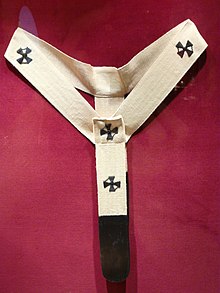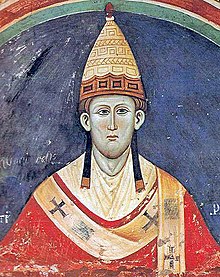
Back Палій Byelorussian Палиум Bulgarian Pal·li Catalan Pallium Czech Paliwm Welsh Pallium Danish Pallium German Πάλλιον Greek Paliumo (liturgio) Esperanto Palio (indumentaria religiosa) Spanish


The pallium (derived from the Roman pallium or palla, a woolen cloak; pl.: pallia) is an ecclesiastical vestment in the Catholic Church,[n 1] originally peculiar to the Pope, but for many centuries bestowed by the Holy See upon metropolitans and primates as a symbol of their conferred jurisdictional authorities,[1] and still remains a papal emblem.[2]
In its present (western) form, the pallium is a long and "three fingers broad" (narrow) white band adornment, woven from the wool of lambs raised by Trappist monks. It is donned by looping its middle around one's neck, resting upon the chasuble and two dependent lappets over one's shoulders with tail-ends (doubled) on the left with the front end crossing over the rear. When observed from the front or rear the pallium sports a stylistic letter 'y' (contrasting against an unpatterned chasuble). It is decorated with six black crosses, one near each end and four spaced out around the neck loop. At times the pallium is embellished fore, aft, and at the left shoulder with three gold gem-headed (dull) stickpins. The doubling and pinning on the left shoulder likely survive from the (simple scarf) Roman pallium.[1]
The pallium and the omophor originate from the same vestment, the latter a much larger and wider version worn by Eastern Orthodox and Eastern Catholic bishops of the Byzantine Rite. A theory relates origination to the paradigm of the Good Shepherd shouldering a lamb, a common early Christian art image (if not icon); the ritual preparation of the pallium and its subsequent bestowal upon a pope at coronation suggests the shepherd symbolism.[citation needed] However, this may be an explanation a posteriori. The lambs whose fleeces are destined for pallia are solemnly presented at altar by the nuns of the convent of Saint Agnes outside the walls[1] and ultimately the Benedictine nuns of Santa Cecilia in Trastevere weave their wool into pallia.
Cite error: There are <ref group=n> tags on this page, but the references will not show without a {{reflist|group=n}} template (see the help page).
- ^ a b c Chisholm 1911, p. 638.
- ^ Schoenig 2006, pp. 18–19.
© MMXXIII Rich X Search. We shall prevail. All rights reserved. Rich X Search